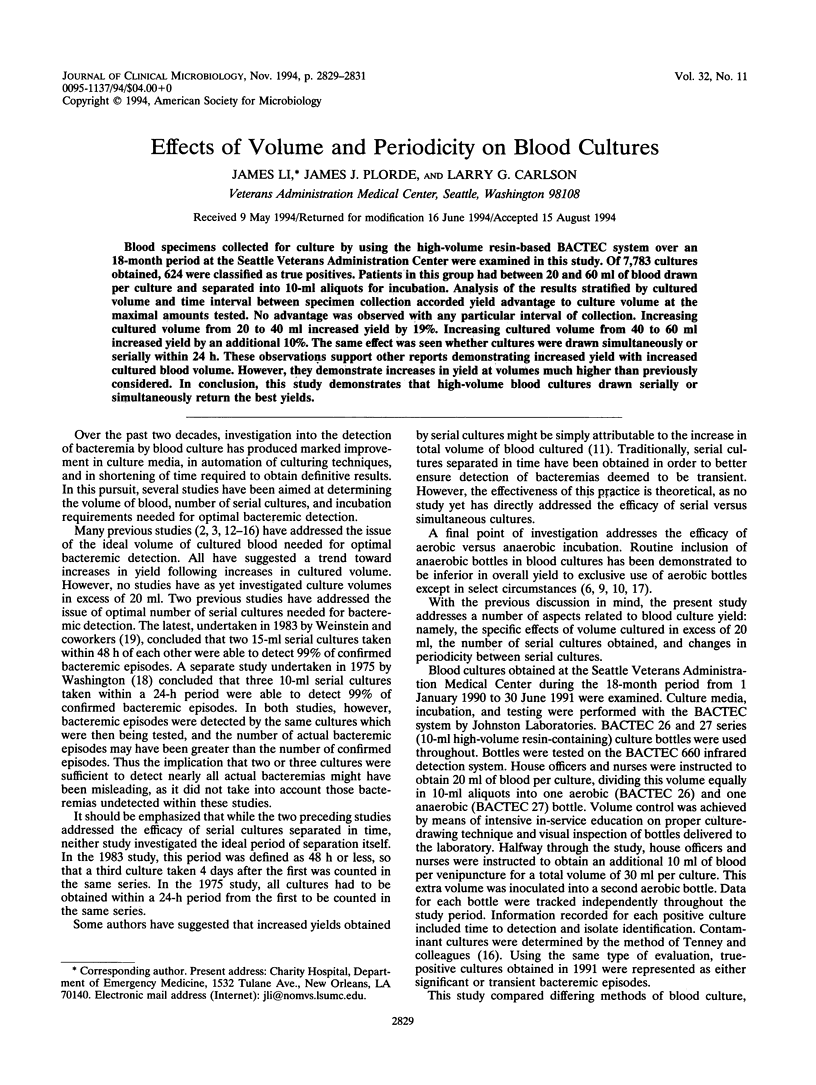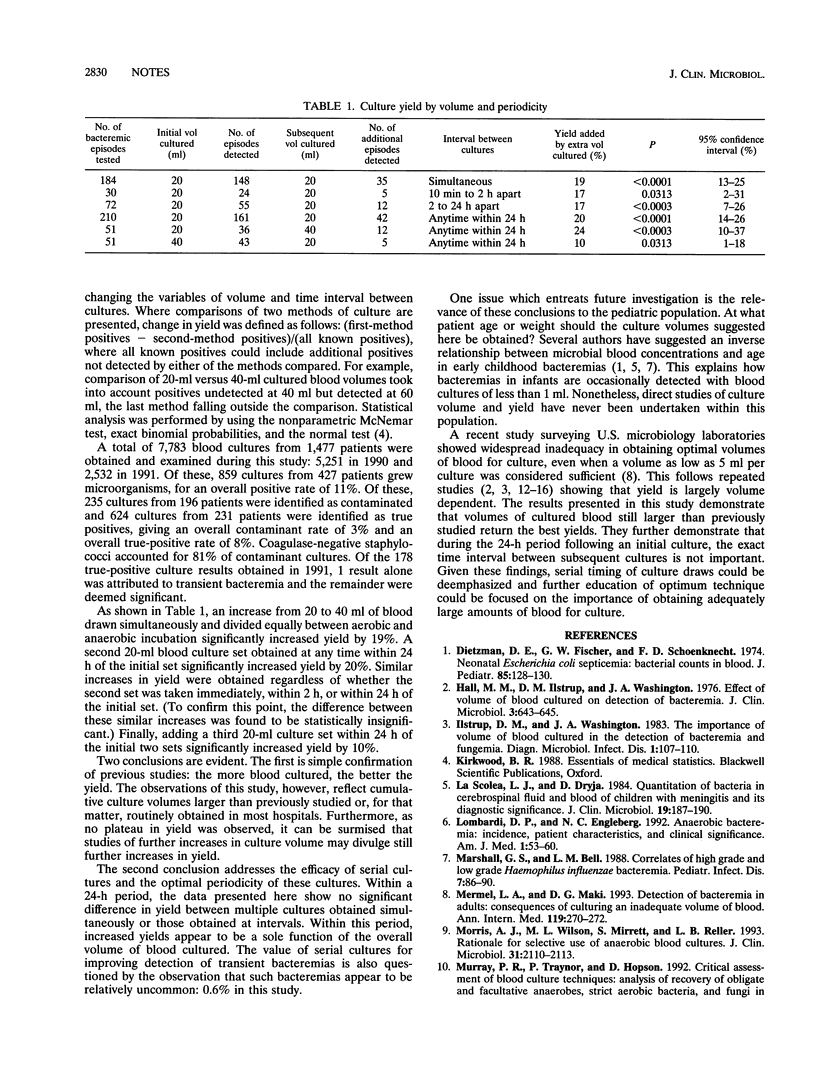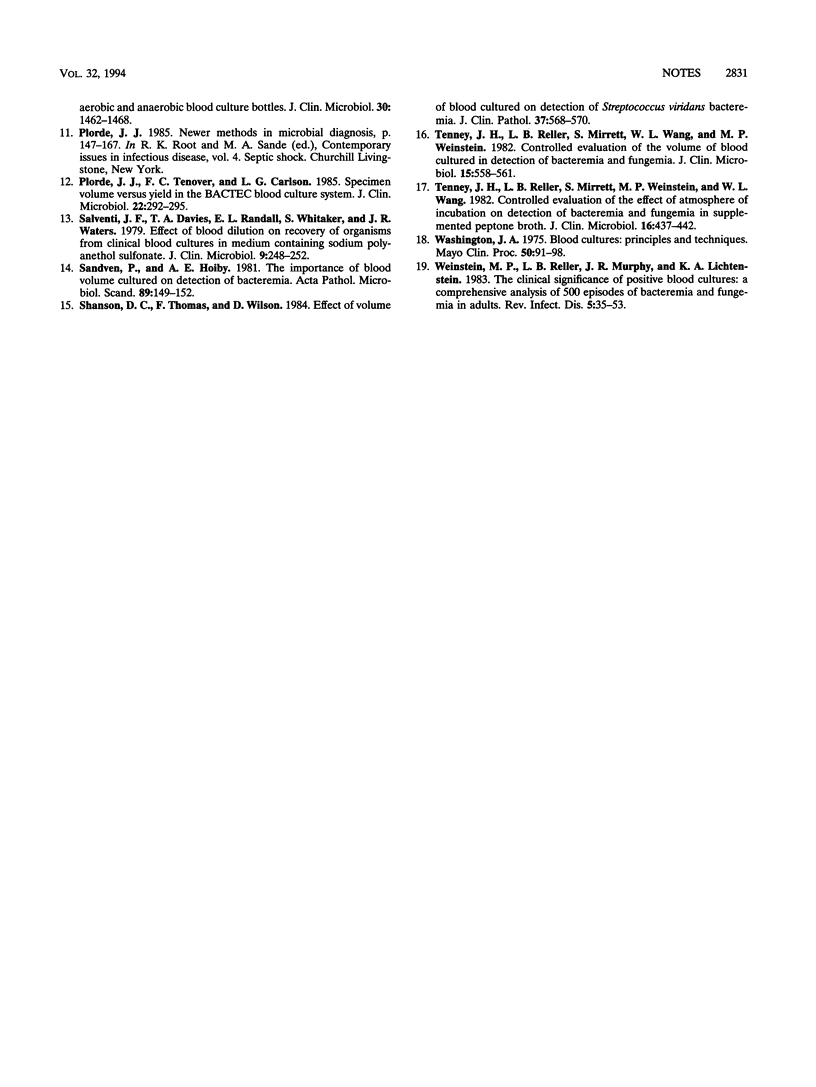Abstract
Blood specimens collected for culture by using the high-volume resin-based BACTEC system over an 18-month period at the Seattle Veterans Administration Center were examined in this study. Of 7,783 cultures obtained, 624 were classified as true positives. Patients in this group had between 20 and 60 ml of blood drawn per culture and separated into 10-ml aliquots for incubation. Analysis of the results stratified by cultured volume and time interval between specimen collection accorded yield advantage to culture volume at the maximal amounts tested. No advantage was observed with any particular interval of collection. Increasing cultured volume from 20 to 40 ml increased yield by 19%. Increasing cultured volume from 40 to 60 ml increased yield by an additional 10%. The same effect was seen whether cultures were drawn simultaneously or serially within 24 h. These observations support other reports demonstrating increased yield with increased cultured blood volume. However, they demonstrate increases in yield at volumes much higher than previously considered. In conclusion, this study demonstrates that high-volume blood cultures drawn serially or simultaneously return the best yields.
Full text
PDF


Selected References
These references are in PubMed. This may not be the complete list of references from this article.
- Dietzman D. E., Fischer G. W., Schoenknecht F. D. Neonatal Escherichia coli septicemia--bacterial counts in blood. J Pediatr. 1974 Jul;85(1):128–130. doi: 10.1016/s0022-3476(74)80308-2. [DOI] [PubMed] [Google Scholar]
- Hall M. M., Ilstrup D. M., Washington J. A., 2nd Effect of volume of blood cultured on detection of bacteremia. J Clin Microbiol. 1976 Jun;3(6):643–645. doi: 10.1128/jcm.3.6.643-645.1976. [DOI] [PMC free article] [PubMed] [Google Scholar]
- Ilstrup D. M., Washington J. A., 2nd The importance of volume of blood cultured in the detection of bacteremia and fungemia. Diagn Microbiol Infect Dis. 1983 Jun;1(2):107–110. doi: 10.1016/0732-8893(83)90039-1. [DOI] [PubMed] [Google Scholar]
- La Scolea L. J., Jr, Dryja D. Quantitation of bacteria in cerebrospinal fluid and blood of children with meningitis and its diagnostic significance. J Clin Microbiol. 1984 Feb;19(2):187–190. doi: 10.1128/jcm.19.2.187-190.1984. [DOI] [PMC free article] [PubMed] [Google Scholar]
- Lombardi D. P., Engleberg N. C. Anaerobic bacteremia: incidence, patient characteristics, and clinical significance. Am J Med. 1992 Jan;92(1):53–60. doi: 10.1016/0002-9343(92)90015-4. [DOI] [PubMed] [Google Scholar]
- Marshall G. S., Bell L. M. Correlates of high grade and low grade Haemophilus influenzae bacteremia. Pediatr Infect Dis J. 1988 Feb;7(2):86–90. doi: 10.1097/00006454-198802000-00003. [DOI] [PubMed] [Google Scholar]
- Mermel L. A., Maki D. G. Detection of bacteremia in adults: consequences of culturing an inadequate volume of blood. Ann Intern Med. 1993 Aug 15;119(4):270–272. doi: 10.7326/0003-4819-119-4-199308150-00003. [DOI] [PubMed] [Google Scholar]
- Morris A. J., Wilson M. L., Mirrett S., Reller L. B. Rationale for selective use of anaerobic blood cultures. J Clin Microbiol. 1993 Aug;31(8):2110–2113. doi: 10.1128/jcm.31.8.2110-2113.1993. [DOI] [PMC free article] [PubMed] [Google Scholar]
- Murray P. R., Traynor P., Hopson D. Critical assessment of blood culture techniques: analysis of recovery of obligate and facultative anaerobes, strict aerobic bacteria, and fungi in aerobic and anaerobic blood culture bottles. J Clin Microbiol. 1992 Jun;30(6):1462–1468. doi: 10.1128/jcm.30.6.1462-1468.1992. [DOI] [PMC free article] [PubMed] [Google Scholar]
- Plorde J. J., Tenover F. C., Carlson L. G. Specimen volume versus yield in the BACTEC blood culture system. J Clin Microbiol. 1985 Aug;22(2):292–295. doi: 10.1128/jcm.22.2.292-295.1985. [DOI] [PMC free article] [PubMed] [Google Scholar]
- Salventi J. F., Davies T. A., Randall E. L., Whitaker S., Waters J. R. Effect of blood dilution on recovery of organisms from clinical blood cultures in medium containing sodium polyanethol sulfonate. J Clin Microbiol. 1979 Feb;9(2):248–252. doi: 10.1128/jcm.9.2.248-252.1979. [DOI] [PMC free article] [PubMed] [Google Scholar]
- Sandven P., Høiby E. A. The importance of blood volume cultured on detection of bacteraemia. Acta Pathol Microbiol Scand B. 1981 Jun;89(3):149–152. doi: 10.1111/j.1699-0463.1981.tb00168_89b.x. [DOI] [PubMed] [Google Scholar]
- Shanson D. C., Thomas F., Wilson D. Effect of volume of blood cultured on detection of Streptococcus viridans bacteraemia. J Clin Pathol. 1984 May;37(5):568–570. doi: 10.1136/jcp.37.5.568. [DOI] [PMC free article] [PubMed] [Google Scholar]
- Tenney J. H., Reller L. B., Mirrett S., Wang W. L., Weinstein M. P. Controlled evaluation of the volume of blood cultured in detection of bacteremia and fungemia. J Clin Microbiol. 1982 Apr;15(4):558–561. doi: 10.1128/jcm.15.4.558-561.1982. [DOI] [PMC free article] [PubMed] [Google Scholar]
- Tenney J. H., Reller L. B., Mirrett S., Weinstein M. P., Wang W. L. Controlled evaluation of the effect of atmosphere of incubation on detection of bacteremia and fungemia in supplemented peptone broth. J Clin Microbiol. 1982 Sep;16(3):437–442. doi: 10.1128/jcm.16.3.437-442.1982. [DOI] [PMC free article] [PubMed] [Google Scholar]
- Washington J. A., 2nd Blood cultures: principles and techniques. Mayo Clin Proc. 1975 Feb;50(2):91–98. [PubMed] [Google Scholar]
- Weinstein M. P., Reller L. B., Murphy J. R., Lichtenstein K. A. The clinical significance of positive blood cultures: a comprehensive analysis of 500 episodes of bacteremia and fungemia in adults. I. Laboratory and epidemiologic observations. Rev Infect Dis. 1983 Jan-Feb;5(1):35–53. doi: 10.1093/clinids/5.1.35. [DOI] [PubMed] [Google Scholar]


